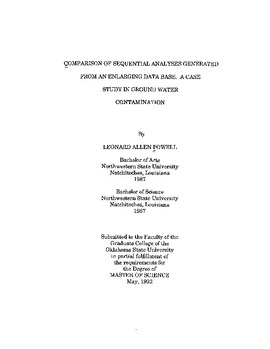| dc.contributor.author | Powell, Leonard Allen | |
| dc.date.accessioned | 2014-11-03T16:09:05Z | |
| dc.date.available | 2014-11-03T16:09:05Z | |
| dc.date.issued | 1992-05-01 | |
| dc.identifier.uri | https://hdl.handle.net/11244/13537 | |
| dc.description.abstract | During my studies of hydrogeology, the question of how much information is truly needed for a dependable analysis of a ground water situation was often brought up. The saying "90% of the information comes from 10% of the data," was presented several times in an almost axiomatical sense. This quote, offered by Dr. Wayne Pettyjohn, served as the basic topic of this thesis. Special thanks go to Dr. Pettyjohn, who served as chairman for my thesis committee. His advice and the data obtained from him made this thesis possible. | |
| dc.format | application/pdf | |
| dc.language | en_US | |
| dc.publisher | Oklahoma State University | |
| dc.rights | Copyright is held by the author who has granted the Oklahoma State University Library the non-exclusive right to share this material in its institutional repository. Contact Digital Library Services at lib-dls@okstate.edu or 405-744-9161 for the permission policy on the use, reproduction or distribution of this material. | |
| dc.title | Comparison of sequential analyses generated from an enlarging data base. a case study in ground water contamination | |
| dc.type | text | |
| osu.filename | Thesis-1992-P884c.pdf | |
| osu.accesstype | Open Access | |
| dc.description.department | Geology | |
| dc.type.genre | Thesis | |
